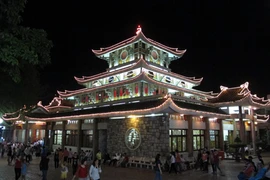Hoa Binh (VNA) – The collection and recording videos of Mo Muong in the northern provinces of Ninh Binh, Son La, Phu Tho and Hoa Binh have been completed, Hoa Binh province’s Department of Culture, Sports and Tourism announced on December 20.
The studies of Mo Muong cultural heritage in Ninh Binh, Son La, Thanh Hoa, Phu Tho provinces and Hanoi have also been finished, it said.
Implementing the instructions of Deputy Prime Minister Vu Duc Dam, the People’s Committee of Hoa Binh province has worked the authorities of Hanoi, Son La, Phu Tho, Ninh Binh, Da Lak, Thanh Hoa and the Ministry of Culture, Sports and Tourism to prepare the national dossiers for Mo Muong which will be submitted to UNESCO to be named in the List of Intangible Cultural Heritage in Need of Urgent Safeguarding.
Mo Muong is a job and also a performance practiced at funerals, religious festivals, and life cycle rituals by the Muong ethnic minority group. Mo Muong has a long life, spanning centuries, as it has always helped to nurture the characteristics and the souls of the Muong people.
It is the essence of labour, production, cultural behaviour and the philosophy of the Muong people, reflecting their love of life and home villages.
Each Muong community has its own version of Mo, but they are all fairly similar. The existence of various versions of Mo has helped expand the heritage and spiritual life of the Muong people.
Regarding the preliminary results of archaeological excavations of two national relics sites, namely Stone Roof of Vanh village in Yen Phu commune and Xom Trai cave in Lac Son district’s Tan Lap commune, Dr Nguyen Viet, Director of the Centre for Southeast Asian Prehistory Studies, said that the excavations aimed to gather more scientific data to enrich the knowledge of Hoa Binh culture and to supplement to the records of local cultural history. They will also serve the education of traditions to younger generations, contributing to socio-economic development, he said.
The excavation of the Stone Roof of Vanh village revealed a number of vestiges of fire stoves and animal bones that may be related to the prehistoric people's seats for making tools or processing food.
The excavation of Xom Trai cave in Tan Lap commune also delivered similar results, Viet said./.




























